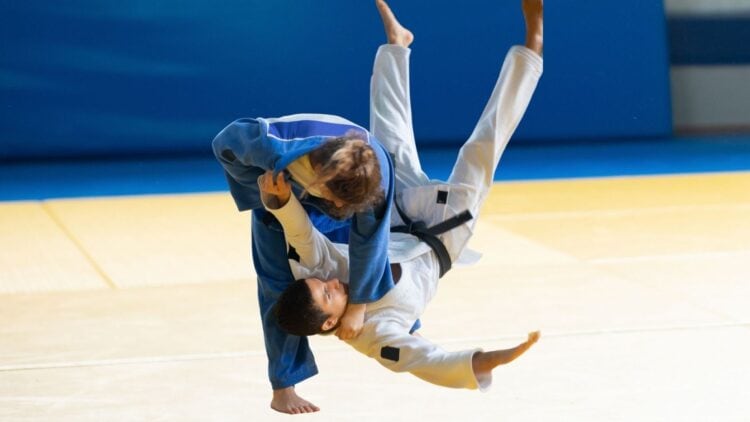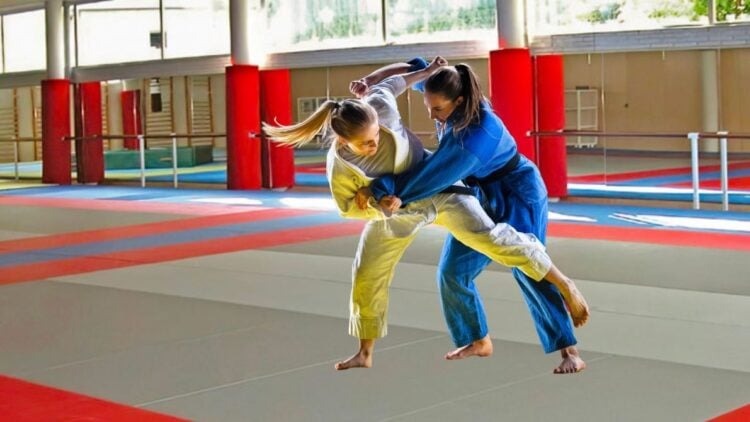
OBJECTIVE OF JUDO: Physically dominate the opponent by pinning them on the ground.
NUMBER OF PLAYERS: 2 players
MATERIALS: Gi, belt, mat
TYPE OF GAME: Sport
AUDIENCE: 4+
OVERVIEW OF JUDO

Judo is a form of Japanese martial arts that is highly centered around technique. Specifically, judo focused on how to bring an opponent – no matter their size – to the ground and on their back. Whilst being an Olympic sport since 1964, judo is also the world’s leading form of “jacket wrestling”, or any form of wrestling in which the goal is to pin the opponent.
Judo’s creation can be attributed to Kanō Jigorō, a Japanese educator, in the late 1880s. Kanō originally took up jujutsu as a means to help him combat the increasing cases of bullying at his school. During this time, he was mentored by Fukuda Hachinosuke, a jujutsu teacher who placed a major emphasis on technique.
Kanō continued to develop his martial arts skills, although he quickly began evolving his jujutsu foundation into one that matched his exact vision. Kanō became very philosophical with his approach to training, and he soon realized that he was no longer practicing jujutsu but rather a new kind of martial art. Because of this, as well as the fact that the general Japanese population looked negatively on jujutsu, Kanō removed the “jutsu” (which means “art” or “means”) and replaced it with “do” (which means “path” or “road”) to better reflect his view on his newfound passion.
Judo became an official Olympic sport in 1964 at the Tokyo games.
SETUP
EQUIPMENT
- Gi: A traditional lightweight judo uniform.
- Belt: A ceremonial belt that is always tied in front with a special knot.
- Mat: A foam-padded mat that covers the floor of judo matches. These are also known as “tatamis”.
WEIGHT CLASSES
Like all martial arts and combat sports, competitors are placed into weight brackets to ensure fair fights. There are seven weight classes that span from extra lightweight to heavyweight. These weight classes can be adjusted for younger competitors. Interestingly, judo also has an open weight division with no weight limit for competitors. This open weight division is held every two years at a judo competition called the World Judo Championship. This exemplifies the judo thought that a much smaller competitor can defeat a larger athlete.
Here are the weight classes for men:
- Extra Lightweight: 60 kg or less (132 lbs)
- Half Lightweight: 66 kg or less (145 lbs)
- Lightweight: 73 kg or less (160 lbs)
- Half Middleweight: 81 kg or less (178 lbs)
- Middleweight: 90 kg or less (198 lbs)
- Half Heavyweight: 100 kg or less (220 lbs)
- Heavyweight: more than 100 kg (220lbs)
And these are the female judo weight classes:
- Extra Lightweight: 48 kg or less (105 lbs)
- Half Lightweight: 52 kg or less (114 lbs)
- Lightweight: 57 kg or less (125 lbs)
- Half Middleweight: 63 kg or less (138 lbs)
- Middleweight: 70 kg or less (154 lbs)
- Half Heavyweight: 78 kg or less (171 lbs)
- Heavyweight: more than 78 kg (171 lbs)
COMPETITION FORMAT
Judo tournaments use a one-versus-one bracket-style format. The participants are ranked in order, by their skills. The top eight judokas (judo participant) are seeded in a way to keep them from matching up with each other too early. The winner of each match moves on to the next round, while the loser is eliminated. In the case of the quarterfinal matchups, the losers compete in repechage matches to determine the bronze medal winner.
Every judo match lasts five minutes, with the match ending early if a competitor can successfully match the winning criterion before time expires.
GAMEPLAY

SCORING POINTS
There are three ways to score in judo:
1) Ippon: A “perfect”, forceful throw in which the opponent lands squarely on their back. A submission that renders the opponent unconscious, forces them to tap out, or pins them on the ground for over 20 seconds also counts as an ippon. An ippon can also be scored once two waza-aris are accumulated. An ippon immediately ends the match and results in a win for the competitor who scored it.
TOP 20 IPPONS – World Championships 2019
2) Waza-ari: A less-forceful throw in which the opponent does not land perfectly on their back. These can also be scored when a competitor pins their opponent on the ground for more than 15 seconds but less than 20 seconds. Two waza-aris equal an ippon (a win). This can be thought of a half point.
3) Yuko: A poor throw or pin that lasts less than 15 seconds. Yukos are only used to determine a match if no ippon or waza-ari has been scored by the time the clock expires.
In the case of a tie, such as both competitors having one waza-ari or the same number of yukos each, a Golden Score tiebreaker ensues. The next competitor to score points of any type wins the match.
BASIC RULES OF JUDO
There are two rule categories in judo: “Shido” (minor) and “Hansoku-make” (major).
Penalties for breaking Shido are minor rule infringements and only result in a warning. Two Shido penalties equal a yuko, three equal a waza-ari, and four equal an ippon for the opponent. Shido penalties include:
- Intentionally avoiding contact with the opponent (being passive)
- Intentionally faking an attack
- Defensively grasping an opponent’s sleeves for more than five seconds
- Hooking a leg or foot in the opponent’s belt
- Strangling an opponent directing with the hands or belt
- Moving outside the contest area
- Bending the opponent’s fingers back
Hansoku-make penalties are major and instantly result in an ippon for the opponent (a loss for the offender). These serious penalties include actions such as:
- Using any of the forbidden techniques (see below)
- Lifting a supine (on stomach) opponent off the ground and throwing them
- Failing to follow the referee’s instructions
- Making meaningless sounds that disrespect the referee or opponent
- Wearing metal/hard objects that could injure the opponent
THE FORBIDDEN JUDO TECHNIQUES
Judo is all about finding the most effective and efficient ways to bring an opponent to the ground, but there are four “forbidden” techniques that are banned from competition because of how dangerous they can be. These include:
- Ashi Garami: Also known as an “entangled leg lock”, this move involves an athlete on the ground using one leg to wrap around one of their opponent’s legs while using their other leg to push the knee of their opponent’s other leg. Essentially, this move almost forces an opponent into a split while one of their legs is being held.
- Do Jime: Known as a “trunk squeeze”, this move involves wrapping the legs around an opponent’s torso and squeezing their sides.
- Kani Basami: Known as the “scissors throw”, this move involves jumping and placing one leg on the front and back sides of an opponent’s knees to bring them to the ground.
- Kawazu Gaki: Known as the “one leg entanglement”, this technique involves placing an arm behind an opponent’s head while trapping one of their legs. To complete this move, the athlete pushes the opponent’s head to the ground while their legs lift off the ground.
JUDO VERSUS JUJUTSU
Considering the founder of judo learned his martial arts skills entirely from jujutsu, it should be no surprise that these two combat disciplines are extremely similar. Both judo and jujutsu are focused on pinning an opponent on the ground and getting them to submit. However, the main difference is that judo is focused on techniques that knock an opponent off-balance and allow them to be thrown to the ground, while jujutsu is focused more on submission techniques that choke the opponent or lock their joints.
A major difference between these sports disciplines is that jujutsu was developed as a form of combat that samurais used during times of war, while judo was developed in a time of peace.
END OF GAME
The judoka that scores an ippon or accumulates more waza-aris or yukos than their opponent wins the judo match.
- 30 GAMES TO PLAY OVER TEXT - April 22, 2024
- 20+ FREE PRINTABLE BABY SHOWER GAMES - April 16, 2024
- 20+ College Party Games for the Best Night Ever! - April 2, 2024